Unit 4 Amazing art Developing ideas Reading 语言点 课件(共29张,内嵌音频) 2024-2025学年高一英语外研版(2019)必修3
文档属性
| 名称 | Unit 4 Amazing art Developing ideas Reading 语言点 课件(共29张,内嵌音频) 2024-2025学年高一英语外研版(2019)必修3 | 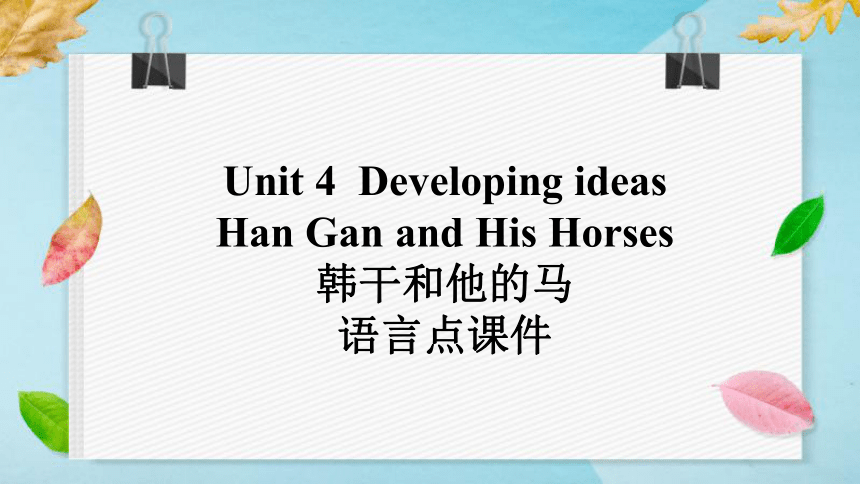 | |
| 格式 | pptx | ||
| 文件大小 | 943.7KB | ||
| 资源类型 | 教案 | ||
| 版本资源 | 外研版(2019) | ||
| 科目 | 英语 | ||
| 更新时间 | 2025-04-27 12:01:49 | ||
图片预览


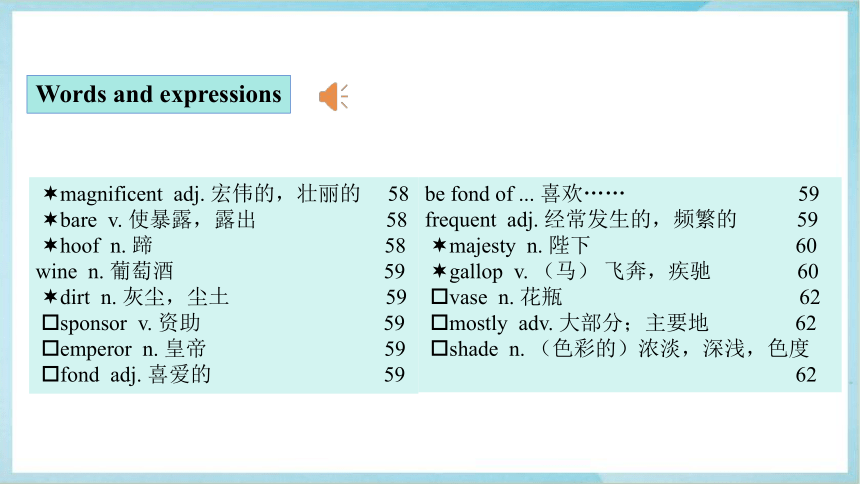
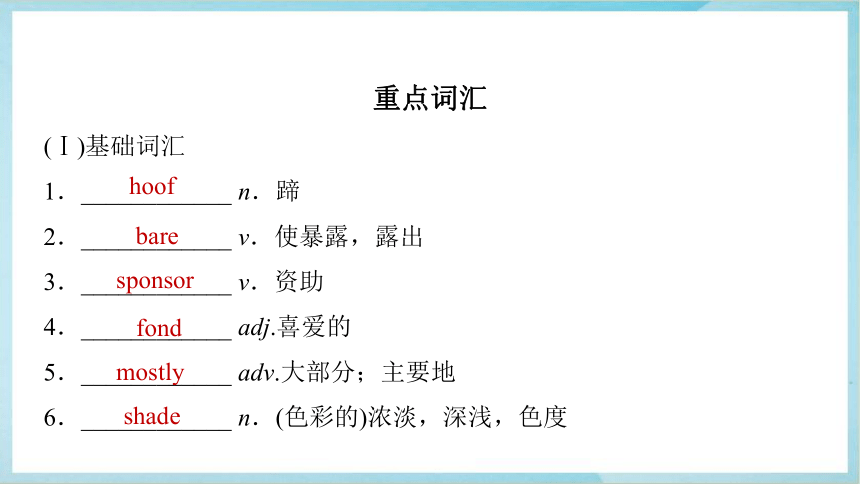
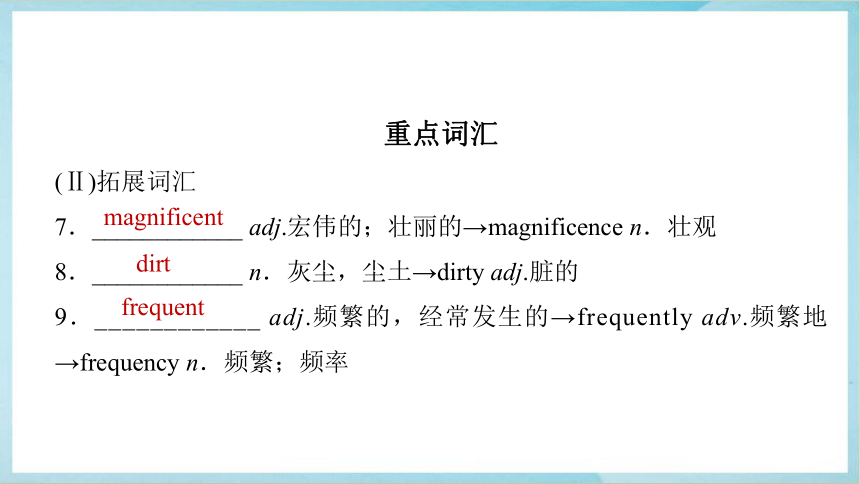


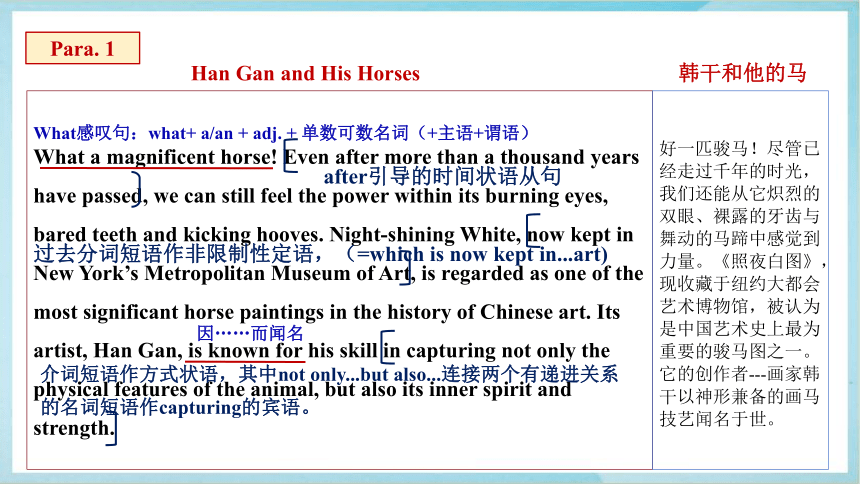
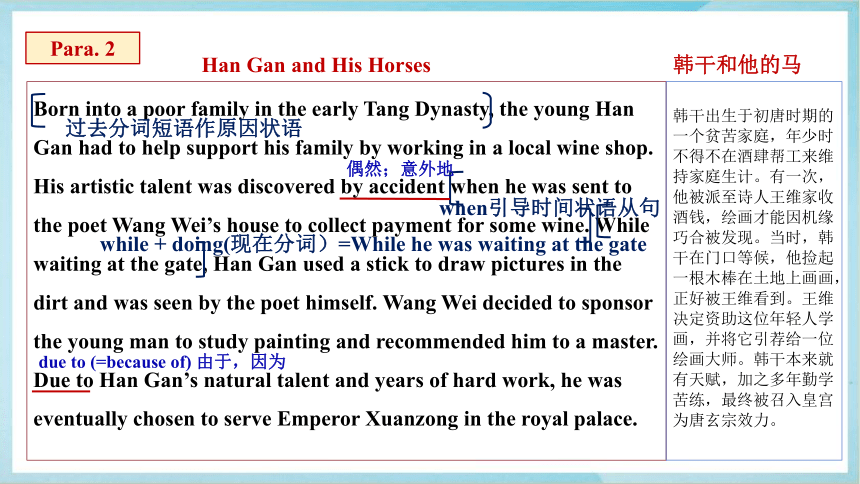
文档简介
(共29张PPT)
Unit 4 Developing ideas
Han Gan and His Horses
韩干和他的马
语言点课件
词汇短语复习巩固
Words and expressions
magnificent adj. 宏伟的,壮丽的 58
bare v. 使暴露,露出 58
hoof n. 蹄 58
wine n. 葡萄酒 59
dirt n. 灰尘,尘土 59
sponsor v. 资助 59
emperor n. 皇帝 59
fond adj. 喜爱的 59
be fond of ... 喜欢…… 59
frequent adj. 经常发生的,频繁的 59
majesty n. 陛下 60
gallop v. (马) 飞奔,疾驰 60
vase n. 花瓶 62
mostly adv. 大部分;主要地 62
shade n. (色彩的)浓淡,深浅,色度
62
重点词汇
(Ⅰ)基础词汇
1.____________ n.蹄
2.____________ v.使暴露,露出
3.____________ v.资助
4.____________ adj.喜爱的
5.____________ adv.大部分;主要地
6.____________ n.(色彩的)浓淡,深浅,色度
hoof
bare
sponsor
fond
mostly
shade
重点词汇
(Ⅱ)拓展词汇
7.____________ adj.宏伟的;壮丽的→magnificence n.壮观
8.____________ n.灰尘,尘土→dirty adj.脏的
9.____________ adj.频繁的,经常发生的→frequently adv.频繁地→frequency n.频繁;频率
magnificent
dirt
frequent
重点短语
1.________________ 偶然,碰巧
2.________________ 由于,因为
3.________________ 喜爱,喜欢
4.________________ 设法做成某事
5.________________ 在行进中
6.________________ 许多
7.____________________ 高度赞扬,高度评价
8.________________ 由……到……不等
by accident
due to
be fond of
manage to do sth.
on the move
plenty of
sing high praises for
range from...to...
课文语法结构分析
What a magnificent horse! Even after more than a thousand years have passed, we can still feel the power within its burning eyes, bared teeth and kicking hooves. Night-shining White, now kept in New York’s Metropolitan Museum of Art, is regarded as one of the most significant horse paintings in the history of Chinese art. Its artist, Han Gan, is known for his skill in capturing not only the physical features of the animal, but also its inner spirit and strength.
Para. 1
after引导的时间状语从句
过去分词短语作非限制性定语,(=which is now kept in...art)
好一匹骏马!尽管已经走过千年的时光,我们还能从它炽烈的双眼、裸露的牙齿与舞动的马蹄中感觉到力量。《照夜白图》,现收藏于纽约大都会艺术博物馆,被认为是中国艺术史上最为重要的骏马图之一。它的创作者---画家韩干以神形兼备的画马技艺闻名于世。
Han Gan and His Horses 韩干和他的马
What感叹句:what+ a/an + adj. + 单数可数名词(+主语+谓语)
因……而闻名
介词短语作方式状语,其中not only...but also...连接两个有递进关系的名词短语作capturing的宾语。
Born into a poor family in the early Tang Dynasty, the young Han Gan had to help support his family by working in a local wine shop. His artistic talent was discovered by accident when he was sent to the poet Wang Wei’s house to collect payment for some wine. While waiting at the gate, Han Gan used a stick to draw pictures in the dirt and was seen by the poet himself. Wang Wei decided to sponsor the young man to study painting and recommended him to a master. Due to Han Gan’s natural talent and years of hard work, he was eventually chosen to serve Emperor Xuanzong in the royal palace.
Para. 2
while + doing(现在分词)=While he was waiting at the gate
过去分词短语作原因状语
when引导时间状语从句
韩干出生于初唐时期的一个贫苦家庭,年少时不得不在酒肆帮工来维持家庭生计。有一次,他被派至诗人王维家收酒钱,绘画才能因机缘巧合被发现。当时,韩干在门口等候,他捡起一根木棒在土地上画画,正好被王维看到。王维决定资助这位年轻人学画,并将它引荐给一位绘画大师。韩干本来就有天赋,加之多年勤学苦练,最终被召入皇宫为唐玄宗效力。
Han Gan and His Horses 韩干和他的马
偶然;意外地
due to (=because of) 由于,因为
The Tang emperors were very fond of horses. This meant that the animal was a frequent subject for artists. At that time, the most common way to study horse painting was by copying the works of previous painters. Han Gan’s method, however, was different --- he observed the animal itself. He was a frequent visitor to the royal stables and even moved in to live with the stable workers for quite some time. The horses, whether resting or on the move, offered him plenty of inspiration. The more time he spent observing these animals, the more his understanding of them grew. Day after day, Han Gan painted the horses, his brush presenting every detail that he saw with his own eyes.
Para. 3
独立主格结构:名词/代词+现在分词 在句中作方式状语。
that引导表语从句
whether + doing(现在分词)作方式状语=whether they were resting or on the move
唐代的皇帝十分喜欢骏马,马因此成为了画家笔下的常见主题。当时学习画马最普通的方法是临摹前人留下的画作。但韩干却采用了不同的方法---他去观察真的马。他是皇家马厩的常客,甚至直接搬到马厩中与马夫同住了好一段时间。无论是静止休息的马还是动态性进的马,都给韩干带来很多灵感。他观察的时间越长,对马的了解程度就越深。韩干日复一日地练习画马,用画笔把眼睛观察到的每一处细节都呈现出来。
Han Gan and His Horses 韩干和他的马
喜欢……; 擅长……
在行进,在运动
越……就越……,表示一方情况随另一方而变,首个the more表条件,第二个表结果。
It is said that when the Emperor asked Han Gan to take a master of horse painting as his teacher, the artist replied, “I have my own teachers, Your Majesty. All the horses in your stables are my
very teachers.”
Para. 4
when引导时间状语从句
据说,皇帝曾让他选一位画马大师为师,韩干却回答:“我有自己的老师,陛下。你马厩里所有的马都是我的老师。”
Han Gan and His Horses 韩干和他的马
据说……,it作形式主语,that引导从句作真正的主语。
Those who saw Han Gan’s horse paintings all sang high praises for his unique skill, saying that his horses “could gallon off the paper”. Even Su Shi, the famous poet of the Song Dynasty, expressed his admiration for Han Gan as a master of horse painting with the words, “The horse painted by Han Gan are real horses.”
Para. 5
过去分词短语作定语,修饰the horse。
who指代先行词those,指人,引导定语从句。
that引导的宾语从句,作saying的宾语。
看过韩干的骏马图的人都对他独特的技艺赞赏有加,称他的马“跃然纸上”。就连宋朝的著名诗人苏轼都曾赞扬过韩干画马的卓越才能,他在诗中写道:“韩干画马真是马。”
Han Gan and His Horses 韩干和他的马
对……高度评价;高度赞扬……;盛赞……
表达对……的敬佩之情
词组短语用法解析
重点词组短语
1. be regarded as
2. in the history of
3. be known for...
4. not only...but also...
5. born into...
6. recommend sb./sth. to sb.
7. due to...
8. be fond of...
9. on the move
10. The more..., the more...
11. day after day
12. take sb. as
13. sing high praise for...
14. express one’s admiration for...
1.be regarded as 被认为是;视为;被当做是
He was regarded as the most successful president of modern times.
他被看成是近代最成功的总统。
He seemed to regard the whole thing as a joke.
他似乎是把整件事当成玩笑。
2.in the history of 在……历史上
He was interested in the history of nature.他对自然历史很感兴趣。
This is the third time that they have won the gold medal in the history of
volleyball at the Olympics.这是他们第三次在奥运会上获得排球金牌。
3.be known for... 因为……而闻名
Hangzhou is well known for its West Lake.杭州因西湖而闻名。
Britains are well known for drinking tea.英国人以饮茶而出名。
4.not only...but also...不仅……而且……
He not only read the book, but also remembered what he had read.
他不但读了这本书,而且记住了所读的内容。
5.born into... 出身于...
Born into a family with three brothers, David was brought up to value the
sense of sharing.
出生在一个有三兄弟的家庭,大卫被教育要重视分享意识。
She was born into a very musical family.
她生于音乐之家。
6. sponsor v.资助;赞助
The company sponsored several TV programmes.
这家公司赞助了几个电视节目。
She found a company sponsor her through college.
她找到一家愿资助她读完大学的公司。
7.recommend sb./sth. to sb. 向某人/把某物推荐给某人
I have just spent a holiday there and would recommend it to everyone.
我刚刚在那里度过假,我要把他推荐给每一个人。
拓展:
recommend sb. for... 推荐某人担任……
I will recommend her for your secretary.
recommend doing sth.建议做某事
He recommended reading the book before seeing the movie.
recommend that sb. (should) do sth.建议某人做某事(虚拟语气)
The doctor recommended that I (should) spend two weeks in hospital.
8.due to... 由于,因为
The coast road is closed due to bad weather.
由于天气恶劣,滨海公路暂时封闭。
9.be fond of... 喜欢……(常用于口语)
表示“喜欢”的词汇:
enjoy sth./doing prefer to do/doing sth.
care for go in for
fall/be in love with be keen on
I am fond of English and do well in both speaking and writing.
我喜欢英语,擅长说和写。
I am not fond of detective stories. 我不大喜欢侦探小说。
Peter, not I, is fond of music.
彼得喜欢音乐而我不喜欢。
He is fond of vivacious girls.
他喜欢活泼的女孩。
10.on the move在行进中,移动中;四处奔波
The car was already on the move.
汽车已经开动了。
My mother is always on the move and has little time for herself.
我妈妈总是忙忙碌碌的,几乎没有自己的时间。
The firm is on the move to larger offices.
公司正在迁往更大的办公区。
Jack never wanted to stay in one place for very long, so they were always
on the move.
杰克从不想在一个地方久留,所以他们总在辗转奔波。
11. The more..., the more... 越……,就越……
the + 比较级 (+ 主语+谓语), the + 比较级(+ 主语+谓语)结构,
表示后者随着前者的变化而变化。
The busier he is, the happier he will be.他越忙越高兴。
The higher you stand, the farther you’ll see. 你站的越高就会看的越远。
The more a man knows, the more he is inclined to be modest.
【谚】大智若愚。
12.day after day日复一日;一天又一天
词语辨析 day after day 与 day by day
day after day 可用作状语,有时也可用作主语或宾语,它通常暗示时间之长久。
day by day(一天天地)通常用作状语,且含有逐渐转变的意思。
I felt I was doing the same old thing day after day.
我好像感到一天又一天地做着同样的事情。
13.名词+现在分词 带逻辑主语的现在分词,是一种独立主格形式。在此做状语,通常由名词、名词短语或代词加上动词的非谓语形式等构成。
So many students being absent, the meeting had to be put off.
这么多学生缺席,会议不得不推迟。(原因)
His wallet having been stolen, he didn’t know what to do next.
他的钱包被偷了,他不知道接下来该怎么办。(原因)
另外,独立主格结构除了用表动作的现在分词外,还可用过去分词,不定式这两种非谓语形式以及表状态的名词,形容词,副词和介词短语。在句中经常作原因、条件、让步、结果、伴随状语。
Time permitting, we shall go there on foot. 时间允许的话就步行去那儿。(条件)
The problems solved, we felt relaxed.随着问题的解决,我们感觉轻松了。(伴随)
He came into the room, ears red with cold.
他回到了房间,耳朵冻坏了。(表伴随的状态)
14.本句中It is said that...意为“据说/人们说……”。在该句型中,It是形式主语,that引导主语从句。
(1)It’s reported that... 据报道……
It’s well known that... 众所周知……
It’s thought that... 大家认为……
It’s suggested that... 据建议……
(2)以上结构可以改为下列两种简单句形式:
①sb./sth.be said/thought/reported...+to do sth., 根据具体情况,
过去分词后的动词不定式可以是一般式、进行式(to be doing)或
完成式 (to have done)。
②People/sb.+believe/say/think/report+that...
It is said that she will leave for Wuhan on Tuesday.
据说她周二就要动身去武汉。
It is said that Chinese enjoy crowds.据说中国人喜欢热闹。
15.take sb. as 将某人当作
He took the old woman as his mother.
他把这位老太太当作母亲一样对待。
She took the man as his teacher.
她拜这位男子为师。
16.very adj. (特指人或事物)正是的,恰好的,同一的
Those were her very words.这些都是她的原话。
He might be phoning her at this very moment.
他也许这会儿正在给她打电话呢。
That’s the very thing I need.
那正是我需要的东西。
17.sing high praise for... 高度赞扬...
People all sing high praises for his bravery to stop the robber.
大家都对他阻止住劫匪的勇敢行为高度赞扬。
We sing high praise for Tu Youyou’s contributions to our country.
我们高度赞扬了屠呦呦对我们国家做出的贡献。
He was highly praised for his research on heart disease.
他因对心脏病的研究而获得了高度的赞扬。
类似的:
think much/well of...=think highly of... 看重;对……评价高
think ill/poorly/badly of 认为……不好
短语think highly/well of的被动形式为be highly/well thought of。
As far as I know, the young teacher is highly thought of in his school.
据我所知,这个年轻老师在学校里很受器重。
18.express one’s admiration for... 对……赞赏有加;对……表示钦佩
The teacher expressed his admiration for his students.
这位老师对他的学生赞赏有加。
We all expressed our admiration for our teachers.
我们都对我们的老师表示钦佩。
Out of my unaccountable feelings, I wrote her a letter that
expressed my admiration for her.
出于某种感情,我给她写了一封信,信中表达了我对她的钦佩。
For your timely reply expressed his gratitude at the same time express
our admiration for your work!
对于您的及时回复表示谢谢,同时对您的敬业表示敬佩!
这个年轻人看起来强壮又健康,他告诉我他热爱生活。
The young man looks strong and healthy, and
he often tells me he is fond of life.
2. 我忍受不了日复一日地坐在办公桌前。
I couldn't stand sitting at a desk day after day.
3. 地下室意外失火了。
The basement caught fire by accident.
4. 她对我流利的英语口语赞不绝口。
She sings high praises for my fluent spoken
English./She speaks highly of my...
重点句子汉译英
课堂巩固
韩干和他的马
好一匹骏马!尽管已经走过千年的时光,我们还能从它炽烈的双眼、裸露的牙齿与舞动的马蹄中感觉到力量。《照夜白图》,现收藏于纽约大都会艺术博物馆,被认为是中国艺术史上最为重要的骏马图之一。它的创作者---画家韩干以神形兼备的画马技艺闻名于世。
韩干出生于初唐时期的一个贫苦家庭,年少时不得不在酒肆帮工来维持家庭生计。有一次,他被派至诗人王维家收酒钱,绘画才能因机缘巧合被发现。当时,韩干在门口等候,他捡起一根木棒在土地上画画,正好被王维看到。王维决定资助这位年轻人学画,并将它引荐给一位绘画大师。韩干本来就有天赋,加之多年勤学苦练,最终被召入皇宫为唐玄宗效力。
唐代的皇帝十分喜欢骏马,马因此成为了画家笔下的常见主题。当时学习画马最普通的方法是临摹前人留下的画作。但韩干却采用了不同的方法---他去观察真的马。他是皇家马厩的常客,甚至直接搬到马厩中与马夫同住了好一段时间。无论是静止休息的马还是动态性进的马,都给韩干带来很多灵感。他观察的时间越长,对马的了解程度就越深。韩干日复一日地练习画马,用画笔把眼睛观察到的每一处细节都呈现出来。
据说,皇帝曾让他选一位画马大师为师,韩干却回答:“我有自己的老师,陛下。你马厩里所有的马都是我的老师。”
看过韩干的骏马图的人都对他独特的技艺赞赏有加,称他的马“跃然纸上”。就连宋朝的著名诗人苏轼都曾赞扬过韩干画马的卓越才能,他在诗中写道:“韩干画马真是马。”
1. be regarded as
2. in the history of
3. be known for...
4. not only...but also...
5. born into...
6. recommend sb./sth. to sb.
7. due to...
8. be fond of...
9. on the move
10. The more...,the more...
11. day after day
12. take sb. as
13. sing high praise for...
14. express one’s admiration for...
被认为是;视为;被当做是
因为……而闻名
不仅……而且……
出身于……
向某人/把某物推荐给某人
由于,因为
喜欢……(常用于口语)
在行进中,移动中;四处奔波
越……,就越……
日复一日;一天又一天
将某人当作
在……历史上
复习回顾
高度赞扬……
对……赞赏有加;对……表示钦佩
Recite all the phrases and sentence structures we have learned in class.
Homework
Unit 4 Developing ideas
Han Gan and His Horses
韩干和他的马
语言点课件
词汇短语复习巩固
Words and expressions
magnificent adj. 宏伟的,壮丽的 58
bare v. 使暴露,露出 58
hoof n. 蹄 58
wine n. 葡萄酒 59
dirt n. 灰尘,尘土 59
sponsor v. 资助 59
emperor n. 皇帝 59
fond adj. 喜爱的 59
be fond of ... 喜欢…… 59
frequent adj. 经常发生的,频繁的 59
majesty n. 陛下 60
gallop v. (马) 飞奔,疾驰 60
vase n. 花瓶 62
mostly adv. 大部分;主要地 62
shade n. (色彩的)浓淡,深浅,色度
62
重点词汇
(Ⅰ)基础词汇
1.____________ n.蹄
2.____________ v.使暴露,露出
3.____________ v.资助
4.____________ adj.喜爱的
5.____________ adv.大部分;主要地
6.____________ n.(色彩的)浓淡,深浅,色度
hoof
bare
sponsor
fond
mostly
shade
重点词汇
(Ⅱ)拓展词汇
7.____________ adj.宏伟的;壮丽的→magnificence n.壮观
8.____________ n.灰尘,尘土→dirty adj.脏的
9.____________ adj.频繁的,经常发生的→frequently adv.频繁地→frequency n.频繁;频率
magnificent
dirt
frequent
重点短语
1.________________ 偶然,碰巧
2.________________ 由于,因为
3.________________ 喜爱,喜欢
4.________________ 设法做成某事
5.________________ 在行进中
6.________________ 许多
7.____________________ 高度赞扬,高度评价
8.________________ 由……到……不等
by accident
due to
be fond of
manage to do sth.
on the move
plenty of
sing high praises for
range from...to...
课文语法结构分析
What a magnificent horse! Even after more than a thousand years have passed, we can still feel the power within its burning eyes, bared teeth and kicking hooves. Night-shining White, now kept in New York’s Metropolitan Museum of Art, is regarded as one of the most significant horse paintings in the history of Chinese art. Its artist, Han Gan, is known for his skill in capturing not only the physical features of the animal, but also its inner spirit and strength.
Para. 1
after引导的时间状语从句
过去分词短语作非限制性定语,(=which is now kept in...art)
好一匹骏马!尽管已经走过千年的时光,我们还能从它炽烈的双眼、裸露的牙齿与舞动的马蹄中感觉到力量。《照夜白图》,现收藏于纽约大都会艺术博物馆,被认为是中国艺术史上最为重要的骏马图之一。它的创作者---画家韩干以神形兼备的画马技艺闻名于世。
Han Gan and His Horses 韩干和他的马
What感叹句:what+ a/an + adj. + 单数可数名词(+主语+谓语)
因……而闻名
介词短语作方式状语,其中not only...but also...连接两个有递进关系的名词短语作capturing的宾语。
Born into a poor family in the early Tang Dynasty, the young Han Gan had to help support his family by working in a local wine shop. His artistic talent was discovered by accident when he was sent to the poet Wang Wei’s house to collect payment for some wine. While waiting at the gate, Han Gan used a stick to draw pictures in the dirt and was seen by the poet himself. Wang Wei decided to sponsor the young man to study painting and recommended him to a master. Due to Han Gan’s natural talent and years of hard work, he was eventually chosen to serve Emperor Xuanzong in the royal palace.
Para. 2
while + doing(现在分词)=While he was waiting at the gate
过去分词短语作原因状语
when引导时间状语从句
韩干出生于初唐时期的一个贫苦家庭,年少时不得不在酒肆帮工来维持家庭生计。有一次,他被派至诗人王维家收酒钱,绘画才能因机缘巧合被发现。当时,韩干在门口等候,他捡起一根木棒在土地上画画,正好被王维看到。王维决定资助这位年轻人学画,并将它引荐给一位绘画大师。韩干本来就有天赋,加之多年勤学苦练,最终被召入皇宫为唐玄宗效力。
Han Gan and His Horses 韩干和他的马
偶然;意外地
due to (=because of) 由于,因为
The Tang emperors were very fond of horses. This meant that the animal was a frequent subject for artists. At that time, the most common way to study horse painting was by copying the works of previous painters. Han Gan’s method, however, was different --- he observed the animal itself. He was a frequent visitor to the royal stables and even moved in to live with the stable workers for quite some time. The horses, whether resting or on the move, offered him plenty of inspiration. The more time he spent observing these animals, the more his understanding of them grew. Day after day, Han Gan painted the horses, his brush presenting every detail that he saw with his own eyes.
Para. 3
独立主格结构:名词/代词+现在分词 在句中作方式状语。
that引导表语从句
whether + doing(现在分词)作方式状语=whether they were resting or on the move
唐代的皇帝十分喜欢骏马,马因此成为了画家笔下的常见主题。当时学习画马最普通的方法是临摹前人留下的画作。但韩干却采用了不同的方法---他去观察真的马。他是皇家马厩的常客,甚至直接搬到马厩中与马夫同住了好一段时间。无论是静止休息的马还是动态性进的马,都给韩干带来很多灵感。他观察的时间越长,对马的了解程度就越深。韩干日复一日地练习画马,用画笔把眼睛观察到的每一处细节都呈现出来。
Han Gan and His Horses 韩干和他的马
喜欢……; 擅长……
在行进,在运动
越……就越……,表示一方情况随另一方而变,首个the more表条件,第二个表结果。
It is said that when the Emperor asked Han Gan to take a master of horse painting as his teacher, the artist replied, “I have my own teachers, Your Majesty. All the horses in your stables are my
very teachers.”
Para. 4
when引导时间状语从句
据说,皇帝曾让他选一位画马大师为师,韩干却回答:“我有自己的老师,陛下。你马厩里所有的马都是我的老师。”
Han Gan and His Horses 韩干和他的马
据说……,it作形式主语,that引导从句作真正的主语。
Those who saw Han Gan’s horse paintings all sang high praises for his unique skill, saying that his horses “could gallon off the paper”. Even Su Shi, the famous poet of the Song Dynasty, expressed his admiration for Han Gan as a master of horse painting with the words, “The horse painted by Han Gan are real horses.”
Para. 5
过去分词短语作定语,修饰the horse。
who指代先行词those,指人,引导定语从句。
that引导的宾语从句,作saying的宾语。
看过韩干的骏马图的人都对他独特的技艺赞赏有加,称他的马“跃然纸上”。就连宋朝的著名诗人苏轼都曾赞扬过韩干画马的卓越才能,他在诗中写道:“韩干画马真是马。”
Han Gan and His Horses 韩干和他的马
对……高度评价;高度赞扬……;盛赞……
表达对……的敬佩之情
词组短语用法解析
重点词组短语
1. be regarded as
2. in the history of
3. be known for...
4. not only...but also...
5. born into...
6. recommend sb./sth. to sb.
7. due to...
8. be fond of...
9. on the move
10. The more..., the more...
11. day after day
12. take sb. as
13. sing high praise for...
14. express one’s admiration for...
1.be regarded as 被认为是;视为;被当做是
He was regarded as the most successful president of modern times.
他被看成是近代最成功的总统。
He seemed to regard the whole thing as a joke.
他似乎是把整件事当成玩笑。
2.in the history of 在……历史上
He was interested in the history of nature.他对自然历史很感兴趣。
This is the third time that they have won the gold medal in the history of
volleyball at the Olympics.这是他们第三次在奥运会上获得排球金牌。
3.be known for... 因为……而闻名
Hangzhou is well known for its West Lake.杭州因西湖而闻名。
Britains are well known for drinking tea.英国人以饮茶而出名。
4.not only...but also...不仅……而且……
He not only read the book, but also remembered what he had read.
他不但读了这本书,而且记住了所读的内容。
5.born into... 出身于...
Born into a family with three brothers, David was brought up to value the
sense of sharing.
出生在一个有三兄弟的家庭,大卫被教育要重视分享意识。
She was born into a very musical family.
她生于音乐之家。
6. sponsor v.资助;赞助
The company sponsored several TV programmes.
这家公司赞助了几个电视节目。
She found a company sponsor her through college.
她找到一家愿资助她读完大学的公司。
7.recommend sb./sth. to sb. 向某人/把某物推荐给某人
I have just spent a holiday there and would recommend it to everyone.
我刚刚在那里度过假,我要把他推荐给每一个人。
拓展:
recommend sb. for... 推荐某人担任……
I will recommend her for your secretary.
recommend doing sth.建议做某事
He recommended reading the book before seeing the movie.
recommend that sb. (should) do sth.建议某人做某事(虚拟语气)
The doctor recommended that I (should) spend two weeks in hospital.
8.due to... 由于,因为
The coast road is closed due to bad weather.
由于天气恶劣,滨海公路暂时封闭。
9.be fond of... 喜欢……(常用于口语)
表示“喜欢”的词汇:
enjoy sth./doing prefer to do/doing sth.
care for go in for
fall/be in love with be keen on
I am fond of English and do well in both speaking and writing.
我喜欢英语,擅长说和写。
I am not fond of detective stories. 我不大喜欢侦探小说。
Peter, not I, is fond of music.
彼得喜欢音乐而我不喜欢。
He is fond of vivacious girls.
他喜欢活泼的女孩。
10.on the move在行进中,移动中;四处奔波
The car was already on the move.
汽车已经开动了。
My mother is always on the move and has little time for herself.
我妈妈总是忙忙碌碌的,几乎没有自己的时间。
The firm is on the move to larger offices.
公司正在迁往更大的办公区。
Jack never wanted to stay in one place for very long, so they were always
on the move.
杰克从不想在一个地方久留,所以他们总在辗转奔波。
11. The more..., the more... 越……,就越……
the + 比较级 (+ 主语+谓语), the + 比较级(+ 主语+谓语)结构,
表示后者随着前者的变化而变化。
The busier he is, the happier he will be.他越忙越高兴。
The higher you stand, the farther you’ll see. 你站的越高就会看的越远。
The more a man knows, the more he is inclined to be modest.
【谚】大智若愚。
12.day after day日复一日;一天又一天
词语辨析 day after day 与 day by day
day after day 可用作状语,有时也可用作主语或宾语,它通常暗示时间之长久。
day by day(一天天地)通常用作状语,且含有逐渐转变的意思。
I felt I was doing the same old thing day after day.
我好像感到一天又一天地做着同样的事情。
13.名词+现在分词 带逻辑主语的现在分词,是一种独立主格形式。在此做状语,通常由名词、名词短语或代词加上动词的非谓语形式等构成。
So many students being absent, the meeting had to be put off.
这么多学生缺席,会议不得不推迟。(原因)
His wallet having been stolen, he didn’t know what to do next.
他的钱包被偷了,他不知道接下来该怎么办。(原因)
另外,独立主格结构除了用表动作的现在分词外,还可用过去分词,不定式这两种非谓语形式以及表状态的名词,形容词,副词和介词短语。在句中经常作原因、条件、让步、结果、伴随状语。
Time permitting, we shall go there on foot. 时间允许的话就步行去那儿。(条件)
The problems solved, we felt relaxed.随着问题的解决,我们感觉轻松了。(伴随)
He came into the room, ears red with cold.
他回到了房间,耳朵冻坏了。(表伴随的状态)
14.本句中It is said that...意为“据说/人们说……”。在该句型中,It是形式主语,that引导主语从句。
(1)It’s reported that... 据报道……
It’s well known that... 众所周知……
It’s thought that... 大家认为……
It’s suggested that... 据建议……
(2)以上结构可以改为下列两种简单句形式:
①sb./sth.be said/thought/reported...+to do sth., 根据具体情况,
过去分词后的动词不定式可以是一般式、进行式(to be doing)或
完成式 (to have done)。
②People/sb.+believe/say/think/report+that...
It is said that she will leave for Wuhan on Tuesday.
据说她周二就要动身去武汉。
It is said that Chinese enjoy crowds.据说中国人喜欢热闹。
15.take sb. as 将某人当作
He took the old woman as his mother.
他把这位老太太当作母亲一样对待。
She took the man as his teacher.
她拜这位男子为师。
16.very adj. (特指人或事物)正是的,恰好的,同一的
Those were her very words.这些都是她的原话。
He might be phoning her at this very moment.
他也许这会儿正在给她打电话呢。
That’s the very thing I need.
那正是我需要的东西。
17.sing high praise for... 高度赞扬...
People all sing high praises for his bravery to stop the robber.
大家都对他阻止住劫匪的勇敢行为高度赞扬。
We sing high praise for Tu Youyou’s contributions to our country.
我们高度赞扬了屠呦呦对我们国家做出的贡献。
He was highly praised for his research on heart disease.
他因对心脏病的研究而获得了高度的赞扬。
类似的:
think much/well of...=think highly of... 看重;对……评价高
think ill/poorly/badly of 认为……不好
短语think highly/well of的被动形式为be highly/well thought of。
As far as I know, the young teacher is highly thought of in his school.
据我所知,这个年轻老师在学校里很受器重。
18.express one’s admiration for... 对……赞赏有加;对……表示钦佩
The teacher expressed his admiration for his students.
这位老师对他的学生赞赏有加。
We all expressed our admiration for our teachers.
我们都对我们的老师表示钦佩。
Out of my unaccountable feelings, I wrote her a letter that
expressed my admiration for her.
出于某种感情,我给她写了一封信,信中表达了我对她的钦佩。
For your timely reply expressed his gratitude at the same time express
our admiration for your work!
对于您的及时回复表示谢谢,同时对您的敬业表示敬佩!
这个年轻人看起来强壮又健康,他告诉我他热爱生活。
The young man looks strong and healthy, and
he often tells me he is fond of life.
2. 我忍受不了日复一日地坐在办公桌前。
I couldn't stand sitting at a desk day after day.
3. 地下室意外失火了。
The basement caught fire by accident.
4. 她对我流利的英语口语赞不绝口。
She sings high praises for my fluent spoken
English./She speaks highly of my...
重点句子汉译英
课堂巩固
韩干和他的马
好一匹骏马!尽管已经走过千年的时光,我们还能从它炽烈的双眼、裸露的牙齿与舞动的马蹄中感觉到力量。《照夜白图》,现收藏于纽约大都会艺术博物馆,被认为是中国艺术史上最为重要的骏马图之一。它的创作者---画家韩干以神形兼备的画马技艺闻名于世。
韩干出生于初唐时期的一个贫苦家庭,年少时不得不在酒肆帮工来维持家庭生计。有一次,他被派至诗人王维家收酒钱,绘画才能因机缘巧合被发现。当时,韩干在门口等候,他捡起一根木棒在土地上画画,正好被王维看到。王维决定资助这位年轻人学画,并将它引荐给一位绘画大师。韩干本来就有天赋,加之多年勤学苦练,最终被召入皇宫为唐玄宗效力。
唐代的皇帝十分喜欢骏马,马因此成为了画家笔下的常见主题。当时学习画马最普通的方法是临摹前人留下的画作。但韩干却采用了不同的方法---他去观察真的马。他是皇家马厩的常客,甚至直接搬到马厩中与马夫同住了好一段时间。无论是静止休息的马还是动态性进的马,都给韩干带来很多灵感。他观察的时间越长,对马的了解程度就越深。韩干日复一日地练习画马,用画笔把眼睛观察到的每一处细节都呈现出来。
据说,皇帝曾让他选一位画马大师为师,韩干却回答:“我有自己的老师,陛下。你马厩里所有的马都是我的老师。”
看过韩干的骏马图的人都对他独特的技艺赞赏有加,称他的马“跃然纸上”。就连宋朝的著名诗人苏轼都曾赞扬过韩干画马的卓越才能,他在诗中写道:“韩干画马真是马。”
1. be regarded as
2. in the history of
3. be known for...
4. not only...but also...
5. born into...
6. recommend sb./sth. to sb.
7. due to...
8. be fond of...
9. on the move
10. The more...,the more...
11. day after day
12. take sb. as
13. sing high praise for...
14. express one’s admiration for...
被认为是;视为;被当做是
因为……而闻名
不仅……而且……
出身于……
向某人/把某物推荐给某人
由于,因为
喜欢……(常用于口语)
在行进中,移动中;四处奔波
越……,就越……
日复一日;一天又一天
将某人当作
在……历史上
复习回顾
高度赞扬……
对……赞赏有加;对……表示钦佩
Recite all the phrases and sentence structures we have learned in class.
Homework
